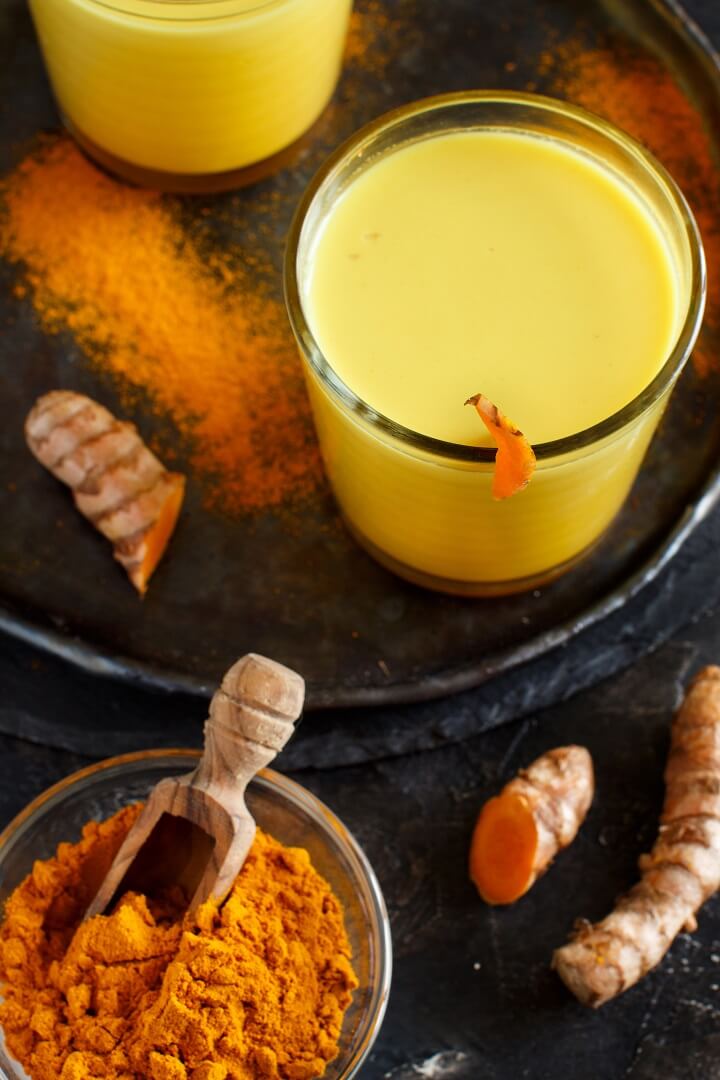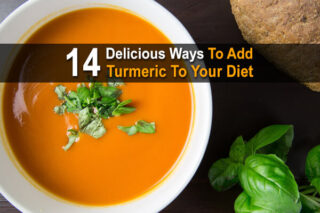Estimated reading time: 11 minutes
Disclaimer: I am not a medical doctor and nothing in this article should be taken as medical advice. Please talk to your doctor before using any of the herbs and/or remedies mentioned in this article. Turmeric has often been referred to as “nature’s antibiotic.” This wonder root can be used in a plethora of ways to help prevent and treat both internal and external health woes.
While turmeric can only be grown outdoors to maturity in a very specific tropical-style environment—which does not include the vast majority of the United States—it can be grown indoors everywhere to the state of maturity needed to harvest the roots and underground stems.
Want to save this post for later? Click Here to Pin It On Pinterest!
The roots and stems (dried rhizomes) are the beneficial part of the turmeric plant. It is the turmeric dried rhizomes that contain curcumin, and it is actually the only source of this vital nutrient on the planet.
Curcuma longa (the scientific name for turmeric) is a perennial herbaceous plant that is a part of the ginger family. The dried rhizomes have been used for centuries by herbalists as a natural healing agent, as a food ingredient or condiment, in aromatherapy, and as a textile dye.
Trust me, folks, it is an excellent dye—it will attach itself to your skin for a few days if you do not wear gloves when handling.
Turmeric Healing Benefits And Compounds
Anti-Inflammatory
Turmeric and the curcumin it contains is most often used in an herbal healing context as an anti-inflammatory compound. It's a superb natural active ingredient in poultices used to treat sore or damaged muscles, tendons, joints, and arthritis.
Curcumin may possess the ability to enhance the lining of blood vessels to help reduce the chance of cardiac problems, respiratory issues, and possibly Alzheimer’s Disease.
The anti-inflammatory properties in the curcumin may also have a positive impact on the five conditions that work in conjunction with one another to cause high cholesterol, high blood sugar, insulin resistance, and excess body fat.
Any combination of these issues may make a person far more vulnerable to developing both heart diseases and diabetes.
Antioxidant
Turmeric is also used for its antioxidant prowess to deter or lessen oxidative stress that may be linked to serious chronic medical conditions like heart disease, cancer, and high blood pressure.
This root contains the same antioxidants found in beta carotene as well as in Vitamins C and E. These compounds may help to fight free radicals that could be linked to cancer.
Cold And Flu
Turmeric and colloidal silver are the “go-to” remedies around our homestead when someone starts to come down with a cold or the flu. The curcumin's anti-inflammatory and antioxidant properties also help to whip out the symptoms most commonly associated with both ailments.
Typically, “Golden Milk” or “Turmeric Juice” or a hot tea made with turmeric are consumed to treat cold and flu symptoms, but the dried spice of a capsule filled with the natural supplement could work as well.

The curcumin in turmeric is notoriously difficult to consume and works through the metabolism rapidly after it does. The best way to absorb and retain the curcumin as long as possible is by taking some black pepper at the same time.
While curcumin is a very effective antioxidant and anti-inflammatory agent, it may not work by itself for its intended purpose. That’s because curcumin in turmeric isn’t easily absorbed and it metabolizes fast.
Wound Healing And Skin Repair
Turmeric may help decrease not only oxidation and inflammation to help wounds heal more quickly, but also decrease the body’s response to cutaneous wounds to foster enhanced tissue healing and collagen production.
As long as you are willing to deal with the temporary orange coloring of the skin that WILL happen when using turmeric as a homemade face mask, this practice may help increase the glow of the skin, heal or prevent acne, decrease the appearance of acne scarring, psoriasis, scabies, lichen planus, alopecia, and eczema.
Turmeric Mask Instructions
- Combine enough honey and Greek yogurt to make a thin (but not too thin) paste.
- Stir in 1 teaspoon of turmeric and combine thoroughly.
- Slather the curcumin infused mask onto the face and allow it to soak into the skin for roughly 15 minutes before gently washing away with lukewarm water.
Stomach Issues And Body Cleansing
Turmeric may help treat and reduce stomach digestion issues such as gas, heartburn, bloating, and diarrhea. The curcumin could enhance the flow of bile to aid the digestion of fat that may lead to indigestions or loss of appetite.
The dry rhizomes from turmeric may also help prevent and rid the body of worms in both human and barnyard or household pets. Typically drinking golden milk, turmeric juice, or turmeric tea is how the spice is used to treat digestion and parasite issues.
Golden milk may also be helpful when consumed as a liver tonic to help treat a “fatty liver” or possibly even cirrhosis.
How To Use Turmeric
Golden Milk
This ancient Indian recipe has been used by herbalists around the globe as a vehicle to deliver turmeric and curcumin to the body so it can get to work healing.
Drinking the turmeric hot milk when cold and flu symptoms begin, especially right before going to bed, can help ward off symptoms. The turmeric may help cleanse the body of microbes and bacteria while reducing mucus production to prevent them from entering the respiratory tract.
Golden milk is tastier and possibly more effective when served hot fresh off the stove, but some folks do store the milk in the refrigerator to keep it at the ready during times of illness. Typically, the turmeric milk should last about one week under refrigeration.
The anti-inflammatory, antioxidant, and antibacterial properties in turmeric may be best released during the heating process. I recommend using whole milk because the fat in it can also aid in absorption.
There are several golden milk recipes, but all contain the same active ingredients:
- Turmeric
- Black pepper
- Ginger
- Cinnamon
- Whole milk from a cow preferably, but goat’s milk can be used as well
- Raw honey
How To Make Golden Milk
Ingredients:
- 1 teaspoon of turmeric
- 1 teaspoon of honey
- ½ teaspoon of black pepper
- ½ cup of milk
- ½ teaspoon of finely grated cinnamon
- ½ teaspoon of ginger – powdered, dried, or shaved
Directions:
- Combine all of the ingredients together in a medium cookpot and stir thoroughly to combine.
- Heat the mixture to boiling while stirring nearly constantly to prevent the milk from developing skin or scorching.
- Once the golden milk has come to a rolling boil, immediately reduce the heat to a simmer for roughly 10 to 12 minutes.
- Use a very fine strainer or a doubled over piece of cheesecloth to filter the turmeric milk mixture through and into mugs.
- Drink the golden milk as soon as you can do so without burning your lips or mouth, for best results.
Turmeric Juice Or Tea
Turmeric juice or tea is far quicker and simpler to make than golden milk and tends to work about as well. Here's how to make it:
- Boil two cups of water and then stir in ½ teaspoon of black pepper and 1 teaspoon of turmeric.
- Simmer the mixture for roughly 10 minutes then add some lemon and honey to taste.
If you drink the mixture hot, it is referred to as a tea; but if you allow it to chill or put it over ice, this same recipe is dubbed turmeric juice.
Turmeric is one of the most important plants I regularly grow and preserve in our apothecary patch. The turmeric plant can be relocated outdoors during the summer months if growing in a container, and then relocated inside once the temperature starts to dip below 75 degrees.
Turmeric Bombs
Not only will turmeric bombs give you a quick little boost when struggling with inflammation or the sniffles, they're also easy to make. I use cute little molds to create fun shapes that are more appealing to the kiddos when they get sick.
Just as with golden milk, there are multiple turmeric bomb recipes floating around the internet. Some are slightly different, but all contain the same core active ingredients. The recipe below is my favorite because all of the ingredients are commonly found in the kitchen pantry and it has always been effective when used on our homestead.
Ingredients:
- 2 teaspoons of turmeric powder
- ¼ cup of coconut oil or coconut butter
- ⅛ teaspoon of black pepper
- ½ teaspoon of ginger powder
- 2 teaspoons of honey
Directions:
- In a medium-sized cook pot, pour in water until it's filled halfway up.
- Bring the water to a boil.
- Place a Mason jar or coffee cup in the pot of lightly boiling water to make a double boiler.
- Add in the coconut oil or coconut butter.
- Stir constantly until the coconut oil or butter has melted completely and to prevent scorching.
- Remove the cooking pot from the store.
- Add in the black pepper, turmeric, honey, and ginger.
- Stir to combine thoroughly. The mixture will turn orange rather quickly courtesy of the turmeric.
- Immediately pour the turmeric bomb mixture into your chosen mold.
- Place the molds on a level spot in the refrigerator and allow them to harden. This takes roughly 2 hours.
The hardened turmeric bombs should keep in a container with a loose-fitting lid in the refrigerator for about two to three weeks. I generally offer two or three of the turmeric bombs to an adult up to four times a day and half that “dosage” up to three times a day for children age two and up.
Turmeric Poultice
Turmeric poultices are excellent to use not only to help foster rapid healing but also to draw out infection from the wound. I have used turmeric poultices often on both human and livestock abscesses and cysts. We also occasionally use turmeric poultices to alleviate pain associated with both arthritis and sore muscles.
Once again, there are many different ways to make a turmeric poultice. The herbs and ingredients used to create the natural healing agent can vary depending on the type of wound, skin problem, or other ailment that is being treated.
The recipe below is my general “go-to” poultice to deal with minor wounds and joint or muscle pain.
Ingredients:
- 1 teaspoon of turmeric powder
- 1 chopped garlic clove
- 1 teaspoon of ginger – grated finely
- 1 teaspoon of honey
- 2 teaspoons of coconut oil
- 1 ½ teaspoon of onion – grated finely – optional but highly recommended
Directions:
- Pour the coconut oil into a cookpot over low heat only. The oil will melt quickly and only needs to melt and become warm. Stir so it does not scorch.
- Stir in all the other ingredients.
- Remove the pot from the heat and pour the coconut oil into a clean bowl—the heat from the pan can still cause scorching.
- Place a bandage, clean piece of cotton, or cheesecloth on the counter and spread the turmeric poultice mixture onto it. I recommend doubling the bandage material so it is not so thin that the poultice mixture does not seep through.
- Wrap the turmeric poultice around the desired area and tie it into place with sports wrap, more cheesecloth, or clean strips of scrap cotton material.
- Allow the turmeric poultice to do its work for about 25 minutes before removing and washing the area clean. Expect the skin to have an orange or yellow cast from the turmeric. Repeat as needed.
Turmeric Food Additive
Sprinkling turmeric in food recipes is yet another simple and effective way to reap the potential healing powers of this wonder spice. While the curcumin will add some orange coloring to any dish it is stirred into, the flavor infused in the dish will be both slight and mild.
I have tossed a pinch or two into family recipes and no one has ever once noticed the change. I would describe the taste of turmeric as “earthy” and mild, akin to slightly spicy ginger.
Turmeric is excellent when used in a dry rub on either wild game or store-bought meat. It also works well in pasta dishes, casseroles, soups, chili, and sandwich spreads.
Harvesting Turmeric
A turmeric plant is ready to harvest about seven months after planting when the stem and leaves begin to turn dry and brown. Cut off the stems about one inch above the rhizomes. Wash the roots and allow them to air dry until they are absolutely 100 percent dry.
The roots can keep in a refrigerator for at least six months, but I recommend powdering the roots and making your own capsules or storing them in an airtight container so the healing herb can last for years.
Like this post? Don't Forget to Pin It On Pinterest!










